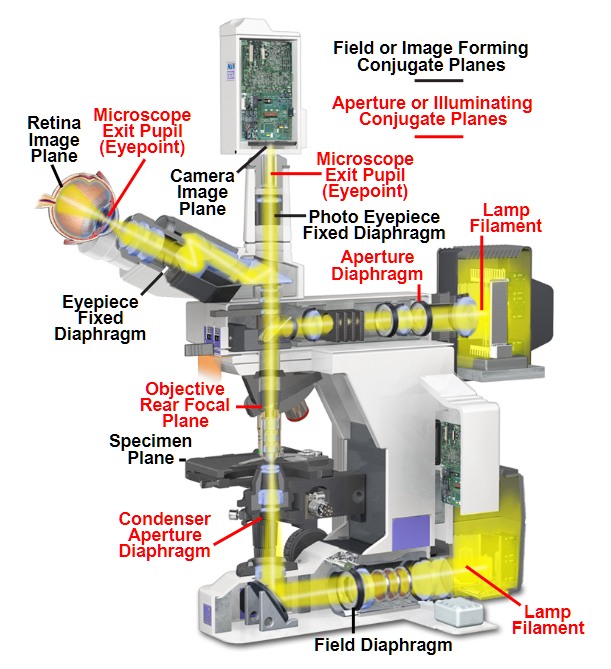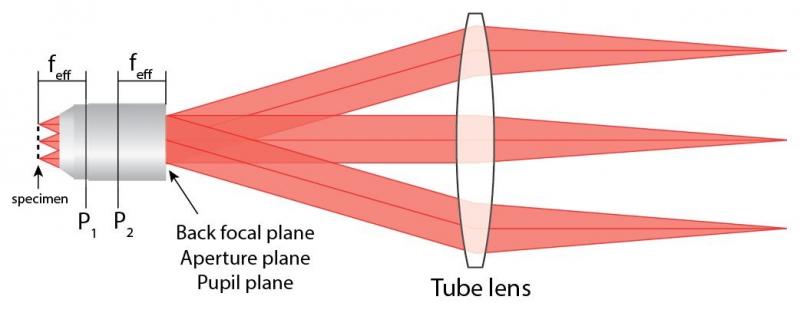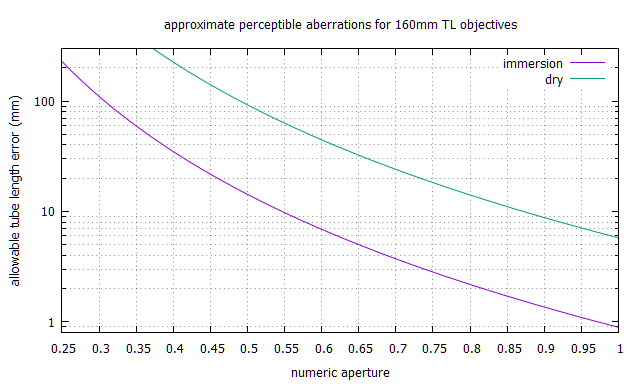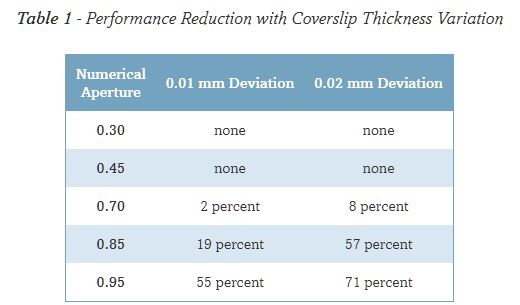back

Microscope BasicsCompound microscope rays compound microscope with both episcope and diascopic illumination Conjugate Planes
Köhler illumination: lamp, field diaphragm and condenser alignmentAny number of websites will waste space pointing out how important it is,then provide miserable, incomplete and wrong instructions. Köhler alignment simply means getting filament focused on objective back focal plane, which will also be in focus at condenser aperture and defocused at object plane. Fortunately, Wikipedia does all right; here are my Köhler experiences. Finite vs infinity objectives; corrections, N.A., image circleTo prime your thinking about lenses and ray diagrams, review this explanation by Bill Otto.The resolving power of an objective on the subject depends only on its N.A., not magnification You can use a 20x 0.75 infinity objective at 40x with a 400mm tube lens, with no degradation relative to a purpose-built 40x 0.75 with a 200mm tube lens. At their specified focal length, objectives vary by useful field circle diameter. Before 1980, 18mm was typical; modern Nikon Plan objectives can be 22mm or more.  Finite-conjugate microscope system vs. infinite-conjugate microscope system with tube lens. from: Systematic design of microscope objectives The vertical dotted line where rays cross at right end of tube length is called the objective's rear conjugate. To the extent that it is, a finite objective's correction is designed for that tube length, keeping in mind than many objectives also depend on both slide cover glass and eyepiece for correction. More explanationThe upper diagram is supposed to represent a traditional (RMS == Royal Microscope Society) microscope."tube length" is approximately the objective's focal length for its specified magnification, if that objective was a simple convex lens. The lower diagram, which is nominally about more modern microscopes, is arguably also more accurate for some "finite" microscopes, if Objective + Infinity space + Tube lens are considered together as a compensated "finite" objective.While infinity objectives may be used with a tube lens of any focal length, specified magnification depends on that focal length. Infinity microscope vignettingRays from an infinity objective are only parallel when from a single point;with increasing distance between objective and field lens, a larger field lens is needed to avoid vignetting:  An objective's back focal plane is where parallel rays entering that objective focus. Contrast and non-image-forming light.While lenses focus images on your retina or other sensor,they do not prevent other photons from also stimulating sensors. When viewing a three-dimensional scene, perhaps focusing on a near object, photons scattered from more distant objects may also land on the same photosensors. Properly (Köhler) aligned conjugate image and illumination planes also improve contrast. Some non-image-forming light can be blocked by an iris diaphragm, as in this diagram:  Ignore that Microlens Array. Relay part is afocal photography, where Field Lens is the eyepiece or ocular. Corrections and aberrationsLens aberrations exist for 2 main reasons: incorrect geometries and changes in diffraction with wavelength.Correcting aberrations is typically accomplished by combining different simple lenses. In traditional finite compound microscopes, objective aberrations were typically corrected in eyepieces, with the amount of correction differing among manufactures, with mismatches problematic for N.A. >0.6 or so. AO, Reichert, Zeiss and Leica infinity objective are corrected in tube lenseses, typically located near heads' bottom port. Nikon CF and modern Olympus infinity objectives are fully corrected, so useful with e.g. telephoto camera lenses. Lens formulaesimple1/f = 1/do + 1/di {1} di becomes f for infinite do
m = di/do {2} zero magnification for lens focused @ infinity
magnification change by focus distance f = (d2 - d1)/(m2 - m1); {3} alternatively:
d2 = d1 + f*(m2 - m1)
m2 = m1 + (d2 - d1)/fmagnification for classic (RMS) compound microscope m = (L/fo)*(D/fe),...where: m = magnification
L = tube length (160mm)
D = normal vision relaxed distance (250mm)
f = focal length
fo = objective focal length
fe = eyepiece focal length
di = lens to image distance
do = lens to object distance
For 160mm tube length, a 10x objective has 16mm focal length and a 10x eyepiece has 25mm focal length. For infinity scopes, substitute "tube lens focal length" for "tube length". Olympus infinity objectives expect 180mm tube lens focal length; Nikon finite CF BD and M Plan objectives expect 210mm tube length. AberrationsCompensate vs correct Chromatic Aberrations (CA) Apertureeffective (working aperture)m * lens aperture
(m+1) * lens aperture
x * lens aperture
m / (2 * N.A.)equivalent e.g. "How does a 4X N.A. 0.1 objective compare to an f/whatever macro lens?" f=1/(2*N.A.) is not a bad approximation.f=1/(2*N.A.) * M/(M+1), where M is rated magnification.
"pupil ratio" compensates effective aperture for adding extensionaperture vs N.A. : |
| f/# | 1.2 | 1.4 | 1.8 | 2 | 2.8 | 4 | 5.6 | 8 | 11 | 16 |
| N.A. | .4167 | .357 | .417 | .25 | .1786 | .125 | .0893 | .0625 | .045 | .03125 |
Canon EF sensor-to-flange depth: 44mm
Add to extension tubes when testing lens focal lengthsCondensers: achro, aplanatic, Abbe; finite vs infinity
Tweaking Abbe condensersAbbe flaws begin to bother above N.A. 0.6-7; elevate an Abbe to optimize filling the objective's back aperture.
Depth-of-Focus scaling
DoF2 = DoF1 * (f/#2/f/#1) * (m1/m2)**2
Diopter vs focal length: divide into 1000mm, e.g. diopter = 2 for 500mm fl
Zerene macro step size tables: magnification vs frame width, magnification vs aperture
m = sensor width / frame width
0.0022*(((m+1)*f/#)/m)**2
0.00055/(N.A.**2)
Zerene landscape focus tables
1:4 to 8:1 magnification FAQ

Objective standards - DIN: 45mm parfocal distance

Finite tube length error impact on aberrations
- N.A. 0.25 160 TL immersion objectives tolerate over 200mm tube length before issues.
- N.A. 0.65 160 TL immersion objectives tolerate only 5mm tube length error.
Tolerance goes inversely as N.A.^4:

gnuplot
More tube length discussion: Raynox DCR-150 tube assembly with flockingCoverglass thickness error impact vs N.A.
I speculate that zero coverglass (metallurgical) objectives might be usefully more tolerant than coverglass-corrected.
Systematic impact suggests that modest aberrations (e.g. from wrong slide coverslip)
could be mitigated by deliberately changing tube length...
This would provoke magnification change and refocusing inconvenience.
Correcting eyepieces or tube lenseses
Higher objective magnifications are increasingly liable to optical aberrations,
which are greatly reduced in modern larger and more complex infinity objectives,
but earlier systems applied finite objective corrections in compensating eyepieces.
Even highly regarded apochromatic finite objectives were undercorrected for lateral color aberrations.
One speculates that lower power finite objectives may have had aberrations deliberately introduced for compatibility...
cmtalb01 tested correction eyepiece and 40x Zeiss objective combinations:
Notes: - "CPL" is Zeiss "clinical plan" = good enough for eveyday routine use; not Nikon CF photo relay.
- "C5" is a Zeiss C5X eyepiece recommended for achromats, not more highly corrected objectives.
- "DIC" is a Zeiss Epiplan; relatively wide compatibility suggests that 0 coverslip objectives provoke fewer aberrations.
- As might be expected, a CFW eyepiece (applying no corrections) worked poorly with most Zeiss,
but OK with a (perhaps Nikon) Hoffman modulation 40X.